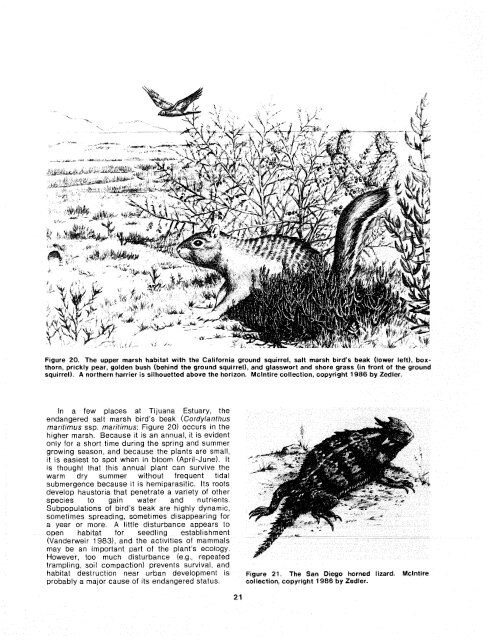The Ecology of Tijuana Estuary, California: An Estuarine Profile
The Ecology of Tijuana Estuary, California: An Estuarine Profile
The Ecology of Tijuana Estuary, California: An Estuarine Profile
Create successful ePaper yourself
Turn your PDF publications into a flip-book with our unique Google optimized e-Paper software.
Figure 20. <strong>The</strong> upper marsh habitat with the <strong>California</strong> ground squirrel, salt marsh bird's beak (lower left), boxthorn,<br />
prickly pear, golden bush (behind the ground squirrel), and glasswort and shore grass (in front <strong>of</strong> the ground<br />
squirrel). A northern harrier is silhouetted above the horiz<br />
In a few places at <strong>Tijuana</strong> <strong>Estuary</strong>, the<br />
endangered salt marsh bird's beak (Cordylanthus<br />
maritimus ssp. maritimus; Figure 20) occurs in the<br />
higher marsh. Because it is an annual, it is evident<br />
only for a short time during the spring and summer<br />
growing season, and because the plants are small,<br />
it is easiest to spot when in bloom (April-June). It<br />
is thought that this annual plant can survive the<br />
warm dry summer without frequent tidal<br />
submergence because it is hemiparasitic. Its roots<br />
develop haustoria that penetrate a variety <strong>of</strong> other<br />
species to gain water and nutrients.<br />
Subpopulations <strong>of</strong> bird's beak are highly dynamic,<br />
sometimes spreading, sometimes disappearing for<br />
a year or more. A little disturbance appears to<br />
open habitat for seediing estabiishrnent<br />
(Vanderweir 19831, and the activities <strong>of</strong> mammals<br />
may be an important part <strong>of</strong> the plant's ecology.<br />
However. too much disturbance (e.g., repeated<br />
trampling, soil compaction) prevents surv~val, and<br />
habitat destruction near urban development is Figure 21. <strong>The</strong> San Diego horned iizard. Mclntire<br />
probably a major cause <strong>of</strong> its endangered status. collection, copyright 1986 by Zedler.<br />
21

















